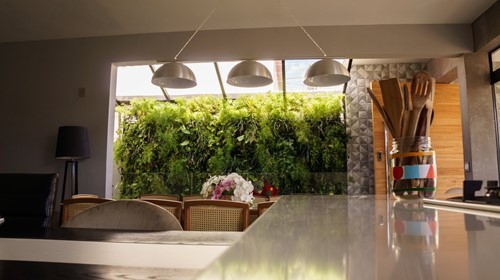
If you're still in the construction phase of your new dream home, or if you'd like to improve your existing home with a small project that gives you back more than just a monetary return, consider adding space for a living wall. A living wall not only gives you something beautiful to look at, it's a bandage for the planet you live on, too.
What Is a Living Wall?
Simply defined, a living wall is a wall made entirely of plants or plant material. A workable solution for both indoor and outdoor spaces, living walls are sometimes called green walls or vertical gardens. Their purpose is to add beauty and oxygen to the atmosphere, while reducing volatile organic compounds and muffling noise.
If you live close to the freeway, outdoor features such as living walls and fountains can help hide the sound of cars passing by. Additionally, your living wall will reduce the fumes generated by vehicle exhaust. This feature is easy to install and requires little in the way of maintenance, but it provides a beautiful space for your eyes to rest. Green walls such as these are environmentally friendly, and when installed in a frequently used area, such as the living room, bathroom, or outdoor patio, bring serenity and peace to your space.
How Do You Install a Living Wall?
Green walls are easy DIY projects, or you can hire a local landscaper to help. Generally, they include a sturdy wooden framework to which you'll affix pockets or planters. The pockets are filled with a lightweight, well-draining soil and outfitted with an irrigation method. Lastly, you'll add plants that will grow and vine, overtaking their planters and hiding the structure. When installed correctly, you'll see only the plants themselves, with none of the framework or tubing visible.
If you're planting your own green wall, you may want to work from a pre-made kit that includes fabric pockets and tubing for irrigation. The pockets are often made of recycled plastic and usually feature a waterproof rubber backing to protect your walls from moisture. There are multiple types of kits available, ranging from easy to complex. Some may require the help of a plumber to add a strategically placed spigot for irrigation.
What Are the Requirements for a Living Wall?
You should keep several factors in mind when installing your green wall. These include:
-
Ensuring your wall is located under sufficient natural light
-
Using plants that are hardy in your climate
-
Keeping interior walls safe from moisture
-
Planting varieties that are non-toxic to children and pets
It's important to use the right materials and to have at least a basic knowledge of gardening when constructing your own green wall. Otherwise, consider hiring a professional to help you install this pretty and functional addition to your living space.
Which Plants Are Best for Living Walls?
If you're installing your vertical garden indoors, you'll need plants that flourish under minimal light. These include:
-
Pothos
-
Lipstick Plant
-
Ferns
-
Wedding vine
-
Peace lily
-
Philodendron
If you're planting an outdoor vertical garden, you must use plants that are hardy to your planting zone. Choose varieties that are leafy and ones that vine and drape attractively. Impatiens, nasturtiums or vinca are all solid options.
What Are the Benefits of Installing a Living Wall?
There are many benefits to adding a living wall to your new or existing home. It generates healthy oxygen and makes rooms smell fresh and clean. A vertical garden also adds interest, texture, and height to your room's design. It's a beautiful, natural element that brings the outdoors inside. And when used outdoors in a sunny climate, can be a refreshing source of shade.
If your space needs a boost, consider the many physical and mental health properties of installing a living wall. You'll love the way it looks and feels, and watching it thrive and flourish can feel therapeutic and satisfying.
About the Author

Eric Lindlau
There are many qualities and skills that go into being an excellent real estate professional - integrity, in-depth community and market knowledge, marketing savvy, effective negotiation skills and a high-quality professional network, all of which are hallmarks of how I work.
